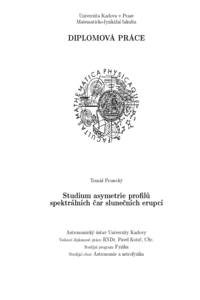Studium asymetrie profilů spektrálních čar slunečních erupcí
Study of the profile asymmetry of the spectral lines in solar eruptions
rigorous thesis (RECOGNIZED)

View/Open
Permanent link
http://hdl.handle.net/20.500.11956/12160Identifiers
Study Information System: 68118
Collections
- Kvalifikační práce [11325]
Author
Faculty / Institute
Faculty of Mathematics and Physics
Discipline
Astronomy and astrophysics
Department
Institute of Theoretical Physics
Date of defense
30. 1. 2008
Publisher
Univerzita Karlova, Matematicko-fyzikální fakultaLanguage
Czech
Grade
Recognized
Spektrální čáry slunečních erupcí mohou vykazovat asymetrické proly. Tento jev může obsahovat informace o rychlostních polích přítomných v různých optických hloubkách a geometrických výškách sluneční atmosféry ovlivněné termálním ohřevem nebo různými netermálními procesy. Spektrální čáry různých prvků zpravidla vznikají v odlišných výškách sluneční atmosféry a mohou tedy nést prostorovou informaci o rozložení a o časovém vývoji rychlostního pole v erupci. V této práci je učiněn pokus analyzovat asymetrie prolů v čáře H u několika pozorovaných erupcí a určit tak vertikální rychlostní pole. Kromě klasické metody bisektorů je též použita metoda srovnávání prolů pozorovaných a spočtených pomocí non-LTE. Možnosti a výsledky obou metod jsou srovnávány a diskutovány.
Spectral lines in solar ares may indicate prole asymmetries. This phenomenon can contain information about velocity elds as present in dierent optical depths and geometric heights of solar atmosphere aected by thermal heating or dierent non-thermal are processes. Spectral lines of various chemical elements originate in dierent heights of solar atmosphere so they can keep information about the spatial distribution and time evolution of velocity eld in the aring atmosphere. To detect vertical velocity eld from observed H proles spectral line prole asymmetries are analysed. In addition to a classical bisector method a method of comparison of the observed and non-LTE calculated proles is used. Possibilities and results of these two methods are compared and discussed.
